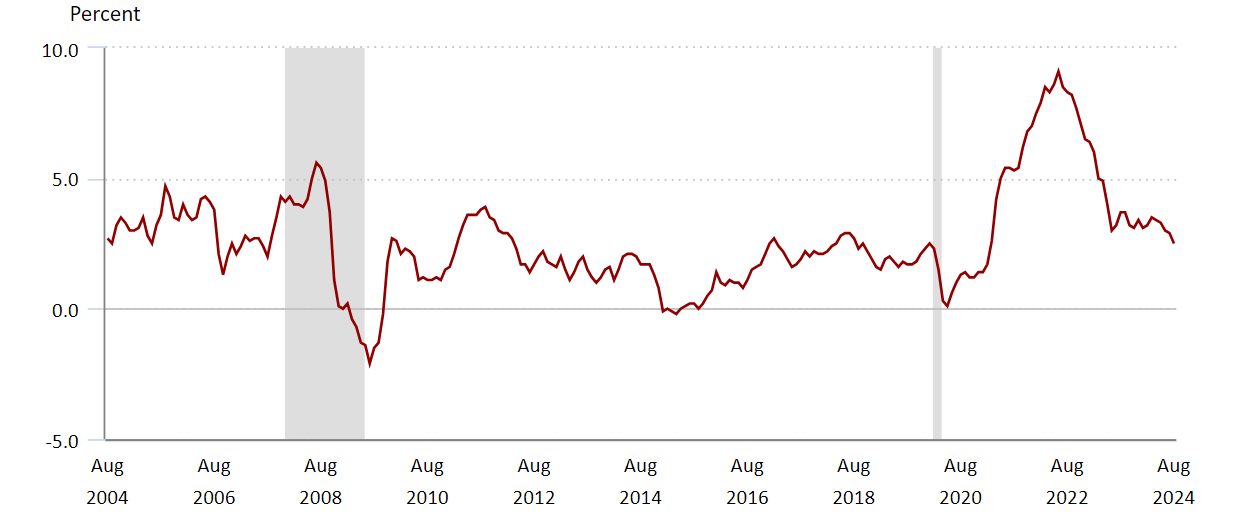A Few Facts for the Home Stretch
I was leafletting at an Early Voting site last week. I say this not to brag but to encourage others to volunteer. In my neck of the woods, when we get into bantering with the Enemy, it’s usually been good-natured and civil.
One older fellow stood opposite us with a sign and tried to get into it with me. First he said, “Boys should not compete in girls’ sports.” I replied, “That’s not a president thing. It’s a state thing.” He responded something to the effect that they were using the election as an opportunity to spread that message. So I basically lost that exchange by resorting to secondary arguments and failing to stand on principle.
Then he started to yak about inflation. I said inflation is over, which is true. He responded yeah but it’s the cumulative effect. Again, not a terrible point. I tried to pull rank, saying I was an economist and I knew what I was talking about. Regardless, he subsequently branded me a “Marxist economist.” This may be true, but it does not hinge on simple questions of fact.
I have been pointing out that the Bidenoid boosterism over the disappearance of inflation glosses over the elevated state of the price level and the more profound point that for many people, things were not hunky-dory before the pandemic and related tribulations. Harping on the unambiguous improvement in the U.S. economy since 2020 glosses over the underlying, long-standing distress of the working class, both black and white. Only racism prevents a wholesale flight of the working class from the Democratic electorate, in light of the party establishment’s many prevarications on basic matters of family finances. We have seen glimmers of relief on this front from the Biden Administration, something to hope for if Harris makes it to the presidency next year. Also, pray for Bernie’s good health.
A few more facts that might help in arguments with Republicans.
Inflation is defined as the increase in the price level of goods and services. (Not financial securities like stocks and bonds, as Justin Raimondo asserted to me years ago.) So inflation could be over but people may still feel the price level is high. A smart person pointed out that when wages rise with or faster than prices, as they have by some metrics, people blame the government for the price increase but attribute the wage increase to their own merits, even though they are linked. It’s an easy misunderstanding for the Enemy to exploit.
There are numerous measures of inflation. One primary source is an agency called the Bureau of Economic Analysis, part of the U.S. Department of Commerce. Another is the Bureau of Labor Statistics, in the Department of Labor. Jerks might discount information from Federal government sources, though of course when Trump was president and the numbers made him look good, they had no problem with those agencies.
Perhaps the best known measure is the Consumer Price Index, from the BLS. Here is a chart of the CPI for the past twenty years:
The grey bars denote recessions. The price level, as measured by the CPI, clearly balloons after 2020. (It started up when DT was still in the White House.) Economic analysis usually attributes this to disruptions of the supply of goods and services due to the pandemic and the start of the war in Ukraine. Some right-wing economists like to blame Federal spending or deficits during Democratic presidencies (never by Republicans).
At any rate, the key points in this context are 1) presidents can’t reduce the price level by fiat. They can pressure it up with a stupid policy like letting a pandemic rage without countervailing measures. 2) the inordinate increases in the price level (inflation) are clearly over. The increases are back to the conventionally desired range of two to four percent annually.
Bottom line, inflation is over. There is a place to talk about unbearably high prices for certain crucial items, such as health care, higher education, and housing. Those are actually things the government can address.
The other leading Republican economic argument centers on energy. “Drill baby drill.” The fact is that the U.S. is already a net exporter of both oil and natural gas. (We sell more than we buy.) There is the faint thread of an argument that more oil and gas production could ease pressure on energy prices, which affect the prices of everything else. Nevertheless, the U.S. does not rely on other countries for oil and gas. We sell more than we consume. Point two, oil and gas prices are set by a cartel led by Trump’s friends in Russia and Saudi Arabia, not by presidents.
In any case, gas prices fell over the second half of 2023, and this year, since May. They average close to $3 a gallon, still not descended to the depths of $2.50, during the Trump Administration. Of course, oil and gas production have increased since then.
The other MAGA bugaboo is immigration, regarding which I like to cite a piece I did on it years ago. Otherwise you can just make fun of anybody you’re arguing with by shouting “They’re eating the cats!”
More recently, we’ve heard the batty argument that immigrants cause inflation. It’s true that population growth puts upward pressure on prices, because more people means more commerce, more wages, and more consumer spending. And by the way, others sources of upward pressure on prices include national economic growth, higher wages, and more white Christian American babies.
Another useful rejoinder is that deporting millions of people who work for low wages will either have them replaced by those earning higher wages, or cause labor shortages, in both cases increasing inflation.
Do facts matter to Republicans, or to anybody? I have my doubts. Nevertheless, having a few in your pocket might make you feel better. See you on the hustings.




